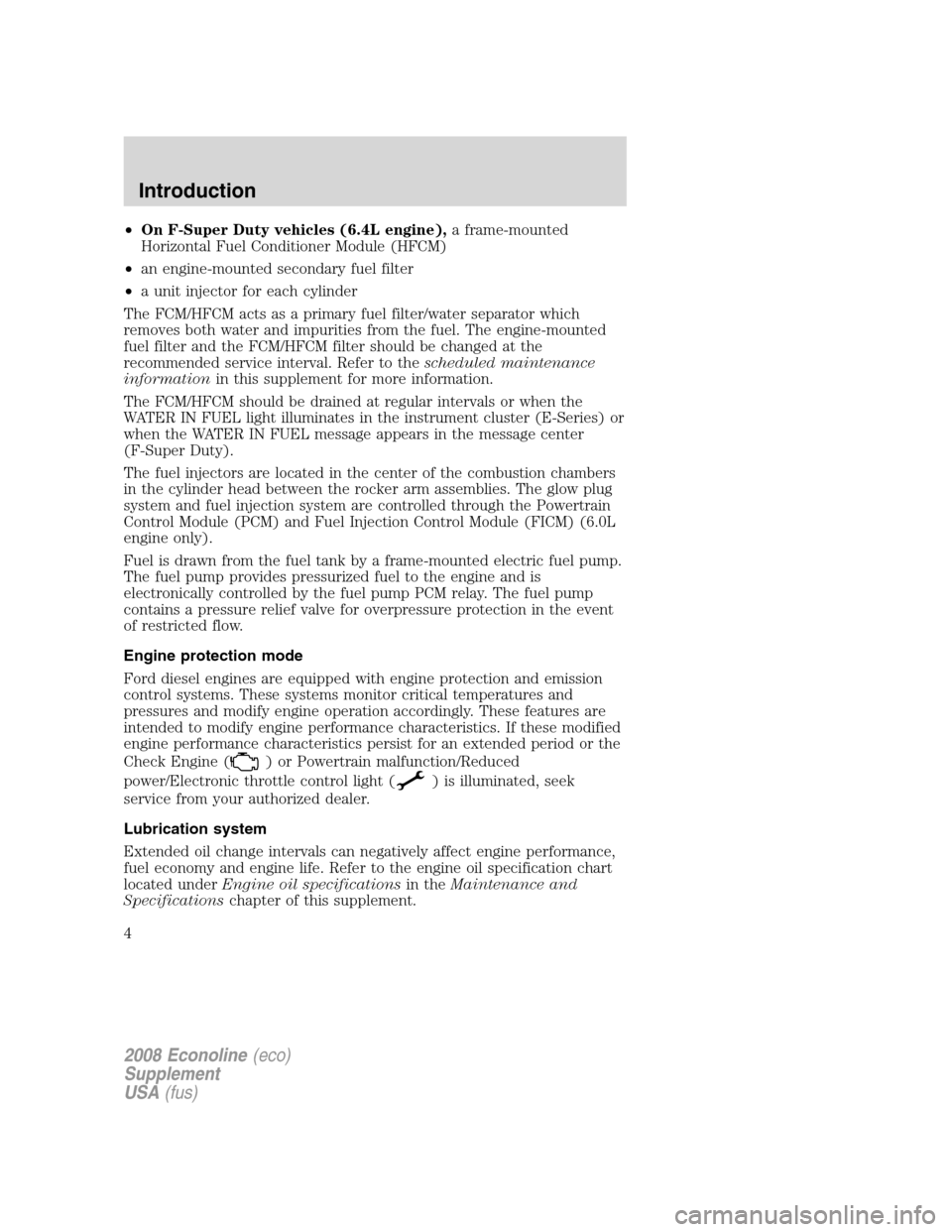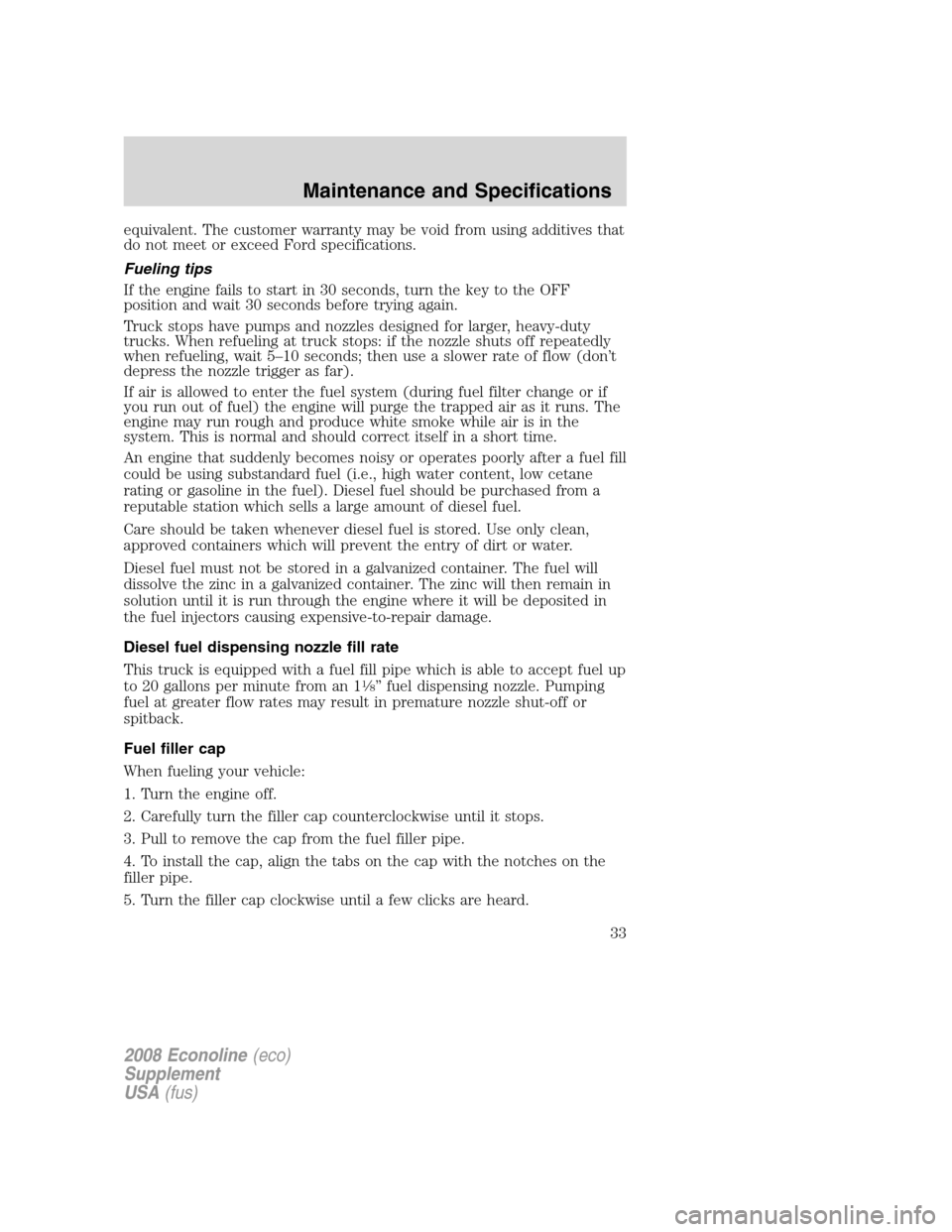Page 4 of 96

•On F-Super Duty vehicles (6.4L engine),a frame-mounted
Horizontal Fuel Conditioner Module (HFCM)
•an engine-mounted secondary fuel filter
•a unit injector for each cylinder
The FCM/HFCM acts as a primary fuel filter/water separator which
removes both water and impurities from the fuel. The engine-mounted
fuel filter and the FCM/HFCM filter should be changed at the
recommended service interval. Refer to thescheduled maintenance
informationin this supplement for more information.
The FCM/HFCM should be drained at regular intervals or when the
WATER IN FUEL light illuminates in the instrument cluster (E-Series) or
when the WATER IN FUEL message appears in the message center
(F-Super Duty).
The fuel injectors are located in the center of the combustion chambers
in the cylinder head between the rocker arm assemblies. The glow plug
system and fuel injection system are controlled through the Powertrain
Control Module (PCM) and Fuel Injection Control Module (FICM) (6.0L
engine only).
Fuel is drawn from the fuel tank by a frame-mounted electric fuel pump.
The fuel pump provides pressurized fuel to the engine and is
electronically controlled by the fuel pump PCM relay. The fuel pump
contains a pressure relief valve for overpressure protection in the event
of restricted flow.
Engine protection mode
Ford diesel engines are equipped with engine protection and emission
control systems. These systems monitor critical temperatures and
pressures and modify engine operation accordingly. These features are
intended to modify engine performance characteristics. If these modified
engine performance characteristics persist for an extended period or the
Check Engine (
) or Powertrain malfunction/Reduced
power/Electronic throttle control light (
) is illuminated, seek
service from your authorized dealer.
Lubrication system
Extended oil change intervals can negatively affect engine performance,
fuel economy and engine life. Refer to the engine oil specification chart
located underEngine oil specificationsin theMaintenance and
Specificationschapter of this supplement.
2008 Econoline(eco)
Supplement
USA(fus)
Introduction
4
Page 9 of 96

During refueling, it is possible for water-contaminated diesel fuel to be
pumped into your tank. Your vehicle’s fuel system is equipped with a fuel
filter/water separator to remove water from the fuel. The WATER IN
FUEL RTT will illuminate when the ignition is turned to START (as part
of the light function check) and when the FCM/HFCM has a significant
quantity of water in it.
If the light illuminates when the engine is running, stop the vehicle as
soon as safely possible, shut off the engine, then drain the FCM/HFCM.
Refer toDraining the FCM/HFCM and changing the engine and
vehicle fuel filtersin theMaintenance and Specificationschapter of
this supplement for the drain procedure. Allowing water to stay in the
system could result in extensive damage to, or failure of, the fuel
injection system.
Do not drain the water separator while the engine is running.
Fuel may ignite if the separator is drained while the engine is
running or the vehicle is moving.
Engine oil pressure (F-Super
Duty only):
Illuminates when the oil pressure
falls below the normal range. Refer
toEngine oilin theMaintenance
and Specificationschapter for more information.
Engine air filter (F-Super Duty only):
The engine air filter warning
message comes on in the message
center when the air filter restriction
gauge reaches the CHANGE FILTER
mark or if the air filter and/or
housing becomes packed with snow.
If airflow is restricted because of snow ingestion, the indicator will
remain on until snow is cleared from the housing, but the vehicle will
still be functional.
The air filter condition should be verified by inspecting the underhood
restriction gauge; the message is only a secondary indicator. Always use
the underhood restriction gauge to determine when the air filter element
needs to be changed.
2008 Econoline(eco)
Supplement
USA(fus)
Instrument Cluster
9
Page 33 of 96

equivalent. The customer warranty may be void from using additives that
do not meet or exceed Ford specifications.
Fueling tips
If the engine fails to start in 30 seconds, turn the key to the OFF
position and wait 30 seconds before trying again.
Truck stops have pumps and nozzles designed for larger, heavy-duty
trucks. When refueling at truck stops: if the nozzle shuts off repeatedly
when refueling, wait 5–10 seconds; then use a slower rate of flow (don’t
depress the nozzle trigger as far).
If air is allowed to enter the fuel system (during fuel filter change or if
you run out of fuel) the engine will purge the trapped air as it runs. The
engine may run rough and produce white smoke while air is in the
system. This is normal and should correct itself in a short time.
An engine that suddenly becomes noisy or operates poorly after a fuel fill
could be using substandard fuel (i.e., high water content, low cetane
rating or gasoline in the fuel). Diesel fuel should be purchased from a
reputable station which sells a large amount of diesel fuel.
Care should be taken whenever diesel fuel is stored. Use only clean,
approved containers which will prevent the entry of dirt or water.
Diesel fuel must not be stored in a galvanized container. The fuel will
dissolve the zinc in a galvanized container. The zinc will then remain in
solution until it is run through the engine where it will be deposited in
the fuel injectors causing expensive-to-repair damage.
Diesel fuel dispensing nozzle fill rate
This truck is equipped with a fuel fill pipe which is able to accept fuel up
to 20 gallons per minute from an 1
1�8” fuel dispensing nozzle. Pumping
fuel at greater flow rates may result in premature nozzle shut-off or
spitback.
Fuel filler cap
When fueling your vehicle:
1. Turn the engine off.
2. Carefully turn the filler cap counterclockwise until it stops.
3. Pull to remove the cap from the fuel filler pipe.
4. To install the cap, align the tabs on the cap with the notches on the
filler pipe.
5. Turn the filler cap clockwise until a few clicks are heard.
2008 Econoline(eco)
Supplement
USA(fus)
Maintenance and Specifications
33